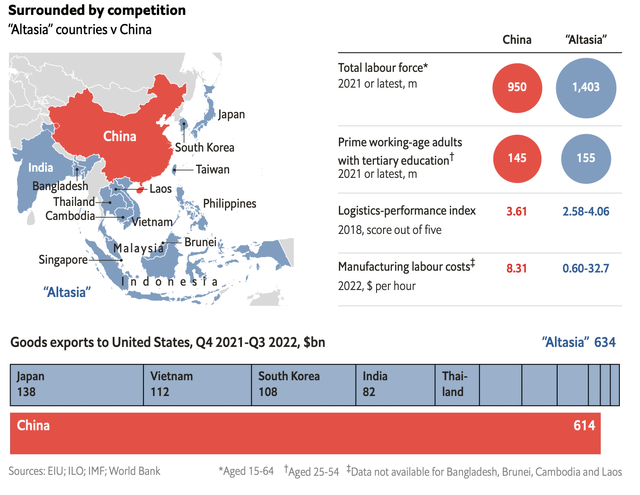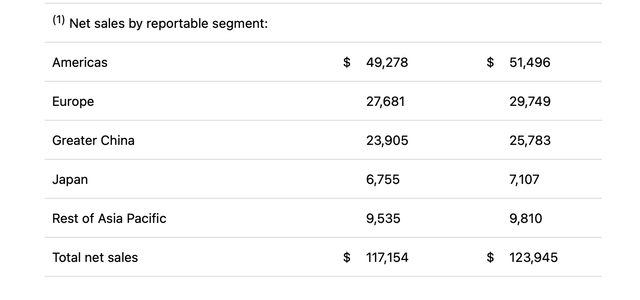Summary:
- Apple is gradually disengaging from potential over-reliance on China manufacturing.
- Rest of Asia segment will become increasingly important for both manufacturing and for sales revenue.
- The agenda of Apple being out of ideas and new products is mistaken.
- The company remains a Buy and Hold stock.
- Strong Services growth with its higher profit margin will lead to increased cash flow for the company.
Shahid Jamil
There is much talk today that Apple (NASDAQ:AAPL) faces an uncertain future due to over-reliance on China. Over the years Apple bears have found multiple reasons to be bearish on the company’s stock. A look at investment returns shows they have been wrong multiple times. I am sure they are wrong again now.
We are seeing a gradual pulling away from over-reliance on China and increased investment elsewhere in Asia. We will see this in both manufacturing and in sales. My article in August last year detailed this.
Asia is the world’s largest continent in terms of population and of the size of the economy size and of economic growth. Growth in Asia will be a sign of strength, not of weakness.
The bear thesis that Apple is running out of ideas has been another long-held mistaken belief and seems to be mistaken again now.
China
A recent meeting in China showed the importance China puts on Apple. CCP mover and shaker Lou Yangsheng met with Apple’s main contract manufacturer, Foxconn (OTCPK:FXCOF) in Henan. Their Zhengzhou factory there is the site of Foxconn’s huge Apple facility, the largest Apple factory in the world. This one facility employs about 300,000 workers. There were well-publicised incidents of worker dissatisfaction there in October last year.
It is not known precisely what was discussed but undoubtedly the Chinese Authorities were urging Foxconn to keep investing in China. A few days after the meeting, Foxconn announced they were investing in a large smart warehouse facility in Henan.
There are approximately 2.5 million Apple software developers alone in China. Over 1 million people are employed in producing Apple products there. The country perhaps needs Apple more than Apple needs China. In addition, there are approximately 150 suppliers to Apple products with manufacturing facilities in China, most of whom are Chinese companies. Compared to this there are an estimated 37 such companies in India and Vietnam. Interestingly more and more of these 150 suppliers are starting to build facilities in countries such as India and Vietnam.
One drawback of China is that manufacturing wages largely doubled between 2013 and 2022. Even more of a drawback is probably overseas companies’ worry over Chinese macro-political ambitions and its relationship with the rest of the world. Premier Xi Jinping has a capricious approach to business. Additionally, the Covid pandemic illustrated to Apple the potential dangers of over-centralisation of operations in just one country. China after Covid seems set to be the biggest driver of economic growth in the world this year and next.
It is possible that Apple will locate or source more manufacturing in the USA. There was talk of this when Taiwanese giant TSMC (TSM) announced its new chip factory in Arizona. Apple will be this facility’s largest customer.
Other international tech companies have recently stated they are pulling some manufacturing out of China. These include Samsung Electronics (OTCPK:SSNLF), which is investing heavily in Vietnam, and Dell Technologies (DELL) which is looking to get semiconductors from sources outside China. As Apple puts in more manufacturing capability across Asia, it will not be the end of the China story for Apple. Relations between China and the USA have been declining for the past 5 years. Tim Cook’s diplomatic skills though have so far navigated a safe path through the problems.
There is little sign of the Chinese consumer tiring of the Apple brand. The illustration below of a new Apple store in Change shows this:
Apple bears have consistently said that the high price of Apple products will doom them to lose market share to competitive quality products from Chinese competitors and from Samsung. They have been consistently wrong. Huawei has entered a huge decline but other brands such as Oppo and Xiaomi make little impact at the Apple level of product. Last year, Apple had the top four selling smartphones in urban areas of the country. Leaving aside the Covid glitch of recent quarters, demand for the whole range of Apple products has been very robust. For instance, 6 out of 10 computer products sold to Chinese consumers are to new users.
Asia Outside China
While the CCP is wooing Foxconn and Apple, at the same time Foxconn is setting up new facilities elsewhere. Most notably this is happening in India and Vietnam. The latter is being seen as a future major manufacturer of tablets, Apple Watch, and AirPods. Recent reports suggest Vietnam might become a manufacturing centre for the MacBook. The network of inter-related logistics facilities and component manufacturers ensures Asia will be the focus for Apple’s manufacturing for years to come.
As the Economist magazine recently pointed out, what they call “Altasia” has many advantages over China. This is illustrated below:
The big advantage China has though is that it is one coordinated market block. The rest of Asia has many models and ASEAN (The Association of South-East Asian Nations) is a not well coordinated body. The RCEP (Regional Comprehensive Economic Partnership) has lumbered into action and should help coordination. However, supply chain links and logistics will take time to match the integrated Chinese domestic market.
Korean and Japanese companies are increasingly following this trend of investments around different countries in Asia. Manufacturing giants such as Sony (SONY) and Samsung have announced substantial investments in the past year.
In the results for Q1 2023 (the 3 months up to 31/12/2022) the break-down of sales was as illustrated below:
34% of sales were in Asia and long-term secular economic trends suggest this percentage increase will continue to keep gathering pace. Asia has a larger population than other continents, it has a younger population, and it has faster economic growth.
At the Q1 analyst call, Apple management stressed how they achieved new revenue records in Indonesia, Vietnam, Thailand, and India. Japan is already the country where Apple has the greatest market penetration of Apple smartphones of any country in the world. Apple has over 500 retail stores worldwide but there are few in this geographic area. The last new one was in Bangkok in 2018. There is one planned to open in Malaysia’s capital, Kuala Lumpur, this year. Such stores drive growth (there are three in tiny Singapore alone). It could be argued that Apple might be better spent investing in a network of physical and online stores around Asia rather than investing vast sums in share buybacks. I think this geographic area will be a very substantial revenue driver in the next few years.
India
At the analyst call, Tim Cook would not be drawn on the precise plans for India but did state:
I am very bullish on India.
Taking India as a separate entity because of its size, it appears it will increasingly become vital as a manufacturing base for Apple. Albeit it will be a gradual process. Last year it was revealed that the company had shifted a meaningful percentage of its iPad production from China to India. India is expected to become the lead manufacturing base for the iPhone 14. This will mainly be from Foxconn’s plant in Chennai. There is also expected to be production from Pegatron’s plant in India. Late last year Foxconn said they were increasing their staff numbers in Chennai fourfold. The iPhone 14 news was officially announced last September. That has led JPMorgan to forecast that 25% of iPhones will be produced in India by 2025. Since 2017 there has been some iPhone assembly, mainly for the SE model, in the country. This is now to be ramped up.
It is being predicted by some analysts that 25% of all Apple products will be manufactured in India within a few years. That seems a bit ambitious to me when you look at the sheer scale of Apple manufacturing. India’s weak infrastructure (when compared to China) with concerns on transport and power shortages are a major hurdle. The stifling bureaucracy is also a problem though it is reported this is improving for foreign investors. Like China, it also has its political problems. Whether its manufacturing quality can match Apple’s stringent quality control is a moot point. It was recently reported that the company had rejected about 50% of casings in one batch supplied locally by Tata.
It is not just in manufacturing that one sees a shift from China to India. Sales revenues are set to follow. Year-on-year Apple is seeing a doubling of sales revenues in India on a quarterly basis. With product being manufactured locally, no doubt the price of retail sales items will drop in a meaningful fashion. It is expected that the first official Apple store will finally open in India soon. However, that has been mooted for years and reflects many of the problems with doing business in India. For instance, the online store has been up and running since 2020 and it has taken this long to add a single retail store. It was reported in December that Apple was signing an agreement with Indian conglomerate Tata. In this, the Indian company would open up at least 100 stores on the basis of it being an authorised Apple reseller.
Future Growth
The lack of growth in the last quarter reflected worldwide economic trends and specifically the Covid problems in China. Looking forward the renewed path to growth looks very rosy.
Already early trends this year show specific strong growth emanating from the new MacBook Pro, the Mac Mini, and the M2 chips. iPad revenues continue to exceed expectations. The new M2 Pro and M2 Pro Max chips in the MacBook Pro and MacMini are faster than anything the competition has. Speed is a vital marketing point for Apple, and the company will no doubt maintain their advantage over the competition. It satisfies current users and attracts new users. This is a factor often overlooked by observers. Early unconfirmed reports suggest Apple is increasing its iPhone market share so far in 2023.
Recent results exceeded expectations in Services revenue. Services revenue produced a record of $20.8 billion in Q1. That would have been even higher if not for a slowdown in App Store business and advertising. That saw a weakness in gaming but strength in subscription business. App Store is reported to be picking up in China but fairly flat elsewhere.
Much of Apple’s revenue growth this year should come from China as the economy rebounds post-Covid.
Services is a very high-margin business for Apple. There is a lot of Services revenue for Apple to lap up amongst its hundreds of millions of subscribers in Music, iCloud subscriptions, TV, Podcasts, and News. This emanates from the huge installed base of 2 billion active devices, a number confirmed at the analyst call. At that call, it was also stated that the company had 935 million paid subscribers. The iOS ecosystem is an incredibly powerful tool for future growth. Tim Cook has previously described it as the company’s “engine of growth”. Sony has a similar competitive advantage over its rivals due to the size of its huge installed PS base.
It is the size of this installed base that really drives Services revenue numbers for Apple. If Goldman Sachs (GS) is correct as per their recent report, Apple will see surging gross profit for the company as a whole based upon its Services growth. Services will continually increase as a proportion of total revenues under this scenario. Goldman Sachs expects that to grow to 40% by fiscal year 2027, up from 33% in fiscal year 2022.
In the long run, areas showing rich promise abound. Apple Watch and healthcare show perhaps the richest promise. My August article gave more detail on this. Outsiders often downplay the huge success Apple Watch has been under Tim Cook’s leadership. It out-sells the whole Swiss watch industry combined. It dominates the smartwatch industry in general. Medical applications include fall detection monitoring, ECG read-outs, and blood oxygen monitoring. Glucose monitoring is the multi-billion business Apple is targeting in a world where diabetes is reaching epidemic proportions. This may though still be a long-term rather than a short-term product realisation. Health applications for watches take a long time to get through approvals.
The rise of AI will be of benefit to the company. As this recent article on SA detailed, the company has a lot of AI applications in its present offerings. These include Face ID, handwriting recognition on Notes, the AppStore workings, and BlueMail. However, as is typical of Apple, they are proceeding slowly and cautiously in what could become a legal mine-field for early starters.
A mooted hardware subscription launch could have very substantial revenue implications. iPhone sales are likely to boom again on the back of the launch of the iPhone 15 and a likely recovery in consumer spending. Other new hardware products will continue to roll out. There is for instance a new “Home Pod” product being launched now. The Apple Car may or may not finally emerge. Personally, I would not factor any revenue into modelling from the auto sector.
AR Headsets may be the one that Apple inwardly expects to give the biggest boost to revenues. Unlike competitors, this is expected to incorporate both augmented and virtual reality technology. It is currently thought that there will be models released in mid-23 for a full roll-out in mid-25.
Conclusion
It is true that investments in China will remain very substantial for Apple. It is also true that macro-political contingencies, in particular an invasion of Taiwan, will remain a concern. However, if China really were to invade then an investor should not worry specifically about his Apple investment. All one’s stock investments are going to be in free fall. The smart money seems to be on 2027 if such an invasion were to take place.
The path going forward for Apple in the next few years looks rosy still. In particular, I believe it will be driven by growth in Asia. This is a factor that most analysts have seemingly failed fully to emphasise. Continued gradual phasing down of Chinese investments will not lead to a lowering on either investment in Asia or sales revenue from Asia. As Apple lessens concentration on China, revenues will grow more strongly in Asia outside China than in China itself.
In some ways, the categories of “growth stock” and “value stock” have become somewhat outdated. For what they are worth though, Apple will uniquely continue to be a great long-term investment as a combination of a value stock and a growth stock. Growing Asian markets and organic product growth will be the biggest factors in this.
Disclosure: I/we have a beneficial long position in the shares of AAPL, SONY either through stock ownership, options, or other derivatives. I wrote this article myself, and it expresses my own opinions. I am not receiving compensation for it (other than from Seeking Alpha). I have no business relationship with any company whose stock is mentioned in this article.



